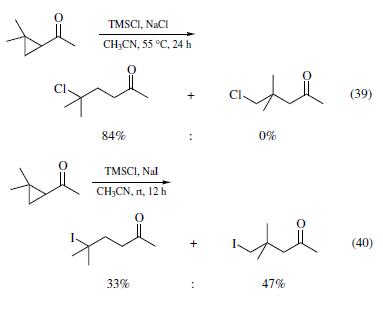クロロトリメチルシラン 化学特性,用途語,生産方法
外観
無色~ほとんど無色, 澄明の液体
溶解性
ジエチルエーテルに極めて溶けやすく、水及びエタノールとは反応する。
解説
クロロトリメチルシラン,金属ケイ素と塩化メチルを銅触媒を用いて高温で反応させるRochowの直接法によって合成される.刺激臭のある無色の液体.融点-40 ℃,沸点57.9 ℃.0.854.1.389.水とはげしく反応し,塩化水素を副生してヘキサメチルジシロキサンを生成する.種々の求核試剤と反応し,合成化学的に有用なシリルエーテル,有機ケイ素化合物などの合成原料となる.腐食性および刺激性がある.
用途
ガスクロマトグラフ分析における試料の前処理剤(トリメチルシリル化剤)。有機合成:和光試薬時報Vol.64 No.2,p.26(1996)、Vol.61 No.3,p.22(1993)。
用途
主たる用途は????????化剤として合成反応に使用される。また、シリコーンオイル、シリコーン系撥水剤等のメチル系シロキサンポリマーの重合鎖末端停止剤である。
化学的特性
Trimethylchlorosilane is a colorless fuming liquid with a pungent odor. Readily hydrolyzed with liberation of hydrogen chloride; soluble in benzene, ether and perchloroethylene. Chlorotrimethylsilane is a chloro-organosilane compound mainly used for silylation reactions.
反応性
Related to the epoxide ring opening, TMSCl also mediates some cyclopropane ring opening reactions. For example, treatment of 1-aceto-2,2-dimethylcyclopropane with TMSCl and sodium chloride in acetonitrile at 55°C for 24 h generated 5-chloro-5-methyl-2-hexanone in 84% yield (eq 39).When sodium iodide was employed to replace sodium chloride, iodotrimethylsilane generated in situ, and the reaction completed under more facile conditions (rt and 12 h). Interestingly, the dominant product is 5-iodo-4,4-dimethyl-2-pentanone (eq 40), arising from iodide attacking at the less hindered secondary methylene carbon, instead of the quaternary dimethylmethylene carbon.

使用
Chlorotrimethylsilane is a typical Silane Blocking Agent, which can protect or deprotect functional groups selectively. It have been used in the preparation of volatile derivatives of a wide range of compounds for GC analysis, and used for silylation and as a protection group in the process of various organic synthesis. It is used in the production of trimethylsilyl halides, pseudohalides and various organic silicon compounds. It is also used to produce hexamethyldisilane by reduction.
定義
ChEBI: Chlorotrimethylsilane is a silyl chloride consisting of a central silicon atom covalently bound to one chloro and three methyl groups. Chlorotrimethylsilane is a derivatisation agent used in gas chromatography/mass spectrometry applications. It has a role as a chromatographic reagent.
一般的な説明
Trimethylchlorosilane appears as a colorless fuming liquid with a pungent odor. Boiling point 135° F, Flash point -18°F. Density 0.854g/cm3. The vapor and liquid may cause burns. Vapors are heavier than air.
反応プロフィール
Chlorotrimethylsilane reacts vigorously and exothermically with water to produce hydrogen chloride.
健康ハザード
Similar to other silanes. Toxicity is rated high for inhalation, ingestion and local irritation. May cause death or permanent injury after a very short exposure to small quantities.
火災危険
Violent reaction with water. Toxic and irritating hydrogen chloride and phosgene may be formed in fires. Difficult to extinguish, re-ignition may occur. Flashback along vapor trail may occur. Containers may explode in fire. Vapor may explode if ignited in enclosed area. When heated to decomposition or on contact with acids or acid fumes, chloride fumes are emitted. Reacts with surface moisture, releasing hydrogen chloride, which will corrode common metals and form flammable hydrogen gas. Avoid contact with water; Chlorotrimethylsilane readily hydrolyzes, liberating hydrochloric acid. Hazardous polymerization may not occur.
安全性プロファイル
Poison by ingestion and
skin contact. Moderately toxic by inhalation
and intraperitoneal routes. A corrosive
irritant to skin, eyes, and mucous
membranes. Questionable carcinogen with
experimental neoplastigenic data. Mutation
data reported. A flammable liquid and very
dangerous fire hazard when exposed to heat
or flame. Violent reaction with water or
hexafluoroisopropylideneamino lithium, A
preparative hazard. To fight fire, use foam,
alcohol foam, fog. When heated to
decomposition it emits toxic fumes of Cl-.
An intermediate in the production of
silicones. See also CHLOROSILASES.
職業ばく露
Trimethylchlorosilane is used as an
intermediate to make silicone products, including lubricants
輸送方法
UN1298 Trimethylchlorosilane, Hazard Class: 3;
Labels: 3-Flammable liquid, 8-Corrosive material.
純化方法
Likely impurities are other chlorinated methylsilanes and tetrachlorosilane (b 57.6o), some of which can form azeotropes. To avoid the latter, very efficient fractional distillation is required. It has been fractionated through a 12 plate glass helices-packed column with only the heart-cut material being used. It has also been fractionated through a 90cm, 19mm diameter Stedman column (p 11). Purify it by redistilling from CaH2 before use. [Sauer et al. J Am Chem Soc 70, 4254 1948, Sauer & Hadsell J Am Chem Soc 70 4258 1948, Langer et al. J Org Chem 23 50 1958, Beilstein 4 IV 4007.] FLAMMABLE and CORROSIVE.
不和合性
Incompatible with oxidizers (chlorates,
nitrates, peroxides, permanganates, perchlorates, chlorine,
bromine, fluorine, etc.); contact may cause fires or explosions.
Keep away from alkaline materials, strong bases,
strong acids, oxoacids, epoxides. Chlorosilanes react
vigorously with bases and both organic and inorganic acids
generating toxic and/or flammable gases. Chlorosilanes
react with water, moist air, or steam to produce heat and
toxic, corrosive fumes of hydrogen chloride. They may also
produce flammable gaseous hydrogen. Attacks metals in
the presence of moisture. Vigorous reaction with aluminum
powder.
廃棄物の処理
Do not discharge into drains
or sewers. Use a licensed disposal contractor to an
approved landfill. Must be disposed properly by following
package label directions or by contacting your local or
federal environmental control agency, or by contacting
your regional EPA office for guidance on
acceptable disposal practices. The most favorable course
of action is to use an alternative chemical product with
less inherent propensity for occupational exposure or environmental
contamination. Recycle any unused portion of
the material for its approved use or return it to the manufacturer
or supplier. Ultimate disposal of the chemical
must consider: the material’s impact on air quality; potential
migration in soil or water; effects on animal, aquatic,
and plant life; and conformance with environmental and
public health regulations.
クロロトリメチルシラン 上流と下流の製品情報
原材料
準備製品
6-ヨード-2-ピリジンカルボン酸
アリルトリメチルシラン
ETHYL 2,4-DIMETHYLQUINOLINE-3-CARBOXYLATE
5-フルオロ-2-ピリジンカルボン酸
ビス(トリメチルシリル)ペルオキシド
(トリフルオロメチル)トリメチルシラン
ロキタマイシン
2-(クロロメチル)-4-メチルキノリン-3-カルボン酸エチル塩酸塩
[[(2E)-1-メチレン-3-メトキシ-2-プロペニル]オキシ]トリメチルシラン
テガフール
ヘキサメチルジシロキサン
(R)-α-[[(4-エチル-2,3-ジオキソピペラジノ)カルボニル]アミノ]ベンゼン酢酸
4-AMINO-2,6-DIFLUORO-BENZALDEHYDE
トリメチルシリルアセチレン
トリメチルシリルアジド
4'-ヨードアセトフェノン
ETHYL 2-(CHLOROMETHYL)-4-PHENYLQUINOLINE-3-CARBOXYLATE
METHYL 2-(CHLOROMETHYL)-4-METHYLQUINOLINE-3-CARBOXYLATE HYDROCHLORIDE
(R)-(-)-α-[[(4-エチル-2,3-ジオキソ-1-ピペラジニル)カルボニル]アミノ]-4-ヒドロキシベンゼン酢酸
ロダニン-3-酢酸
ビス(トリメチルシリル)アセチレン
ETHYL 2-(CHLOROMETHYL)-4-PHENYLQUINOLINE-3-CARBOXYLATE HYDROCHLORIDE
セフォペラゾン
2-(2-アミノエチル)チオフェン
トリス(トリメチルシリル)シラン
6-シアノニコチン酸
トリフルオロメタンスルホン酸2-(トリメチルシリル)フェニル
5-BROMO-3-CHLORO-2-PYRIDINONE
アニラセタム
4-チアゾールカルボキシアルデヒド
2-ETHYL-4-METHYLQUINOLINE-3-CARBOXYLIC ACID
2,4-DIMETHYLQUINOLINE-3-CARBOXYLIC ACID
トリメチルエトキシシラン
N,O-ビス(トリメチルシリル)アセトアミド
1-(2,4-DIMETHYLQUINOLIN-3-YL)ETHANONE HYDROCHLORIDE
2-(2,4-ジメトキシフェニル)エタンアミン
7-アミノセファロスポラン酸
5-ブロモ-3-フルオロ-2-ピリジノン
1,1,1,3,3,3-ヘキサメチルジシラザン
ピリジン - 三酸化硫黄 コンプレックス